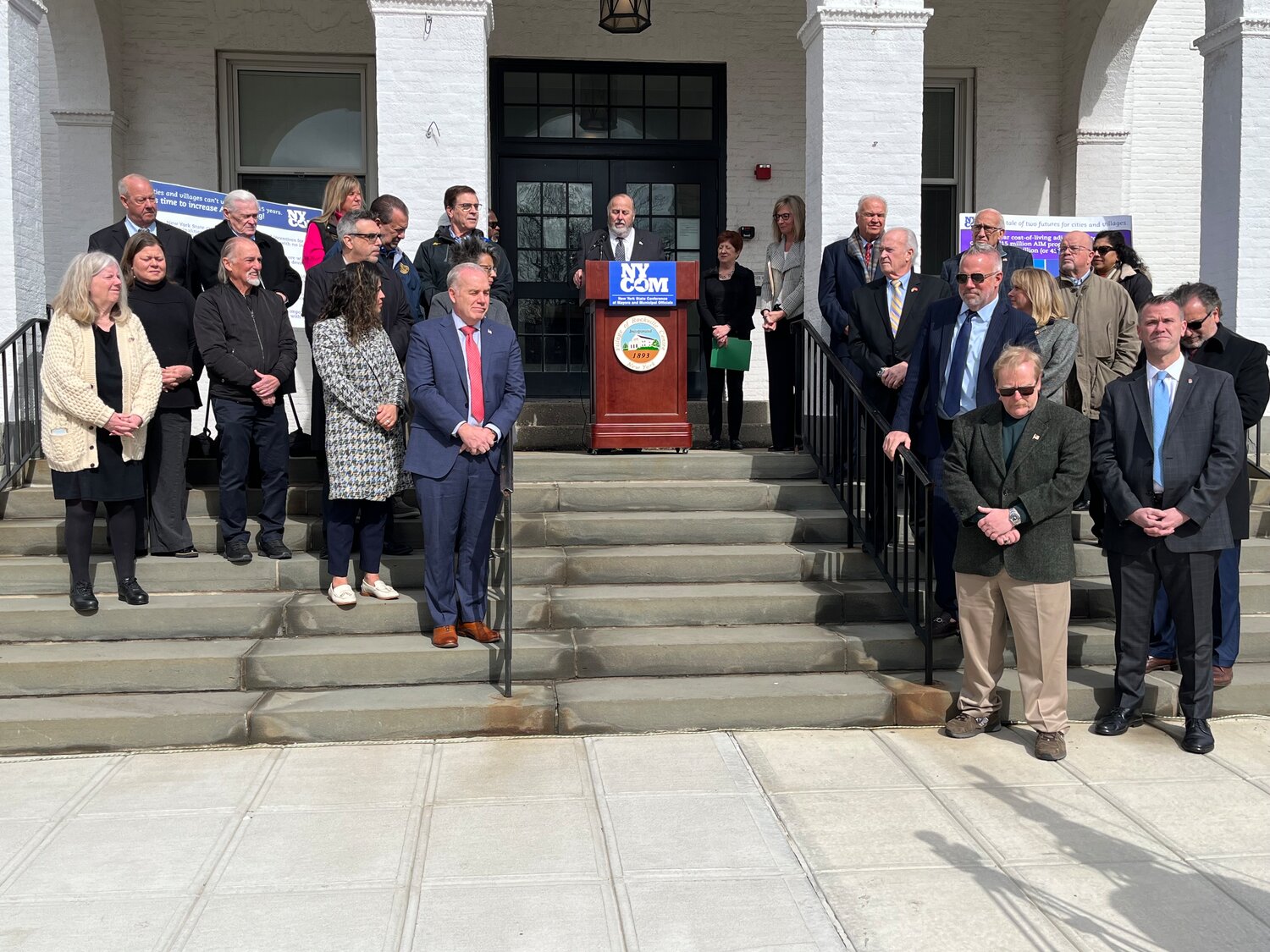NYCOM rallies for more state aid
AIM funding has not increased in 15 years
The New York Conference of Mayors and Municipal Officials joined more than 20 government officials from across Long Island, including Malverne Mayor Tim Sullivan, on the steps of Rockville Centre Village Hall last week for the launch of a statewide campaign to urge Gov. Kathy Hochul and state lawmakers to increase unrestricted aid to cities and villages for the first time in 15 years.
At a news conference on Feb. 22, Mayor Francis X. Murray, the immediate past president of NYCOM, said that the fight to deliver more state funding via the Aid and Incentives for Municipalities program is “unfortunately, a constant theme” for local governments.
Funding for AIM in the 2025 fiscal year is currently budgeted at $715 million — the same as it has been for the past decade and a half. Municipal officials said that the funds directly impact local governments’ ability to respond to growing demands for public safety and other essential services.
“It’s significant because if you think about the rate of inflation, the cost of goods — in particular machinery and equipment and vehicles — has gone up significantly,” Sullivan said. “The increase in everything has been systemic, and the federal aid has dissipated.
“Now we’re looking for another avenue to help us function better from a financial perspective, so we can keep our taxes affordable for residents.”
Albany Mayor Kathy M. Sheehan, the president of NYCOM, said that the hard-earned income tax dollars the state collects are supposed to help ensure that local governments have the necessary funding to address the challenges they face, including aging sewage and water infrastructure and needed improvements in police and fire services.
“And those challenges have only grown, not shrunk,” Sheehan said. “Many years ago, AIM was frozen, and for cities like Albany, it was actually reduced. In fact, the less quote-unquote dependent a municipality was on AIM, the more they were cut.”
Sheehan added that funding for AIM is down roughly 9 percent since the 2009 fiscal year. Meanwhile, the state has continued to increase funding for education and counties.
“We’re doing more with less because that state aid has not grown,” she said. “So when you get that property tax bill, and you worry about being taxed out of your home, one of those causes is the fact that this funding, this sharing of revenue, has stalled and decreased, and it impacts our ability to do all the things that you expect us to do.”
NYCOM Executive Director Barbara Van Epps said that local governments find themselves at a crossroads, because the demand for essential services is rising, while the ability to fund them has not increased as rapidly.
“If we can’t provide those services, either those services are going to be cut or we’re going to have to turn back to our taxpayers in order to fund them, and that’s something we do not want to do,” Van Epps said. “We do not want to raise property taxes. We are subject to a property tax cap. We have a constitutional tax limit. We are restricted in that sense.”
Decades ago, she explained, the state realized that it needed to help local governments provide these services, so it created a revenue-sharing program. The program was intended to share the revenue of the progressive personal income tax as it grew so that local governments wouldn’t need to rely solely on property and sales taxes.
“That was an important step that the state took and it worked,” Van Epps said. “It worked for a long time. But unfortunately, AIM was created in 2006. That is the latest iteration of revenue sharing, when in fact it is not revenue sharing at all. There is no formula. There is no percentage. There is no maximum amount of funding that we are guaranteed year in and year out.”
She said that after speaking with state legislators, NYCOM was told it needed to make some noise to let legislators and the public know about the importance of funding the AIM program.
“You want New York state to be more affordable?” Van Epps said. “You want New York state to be safer? Well, guess what, that’s what local governments want too. So let’s work together to achieve those goals. That’s what we need to do. But we cannot be successful unless the state of New York is willing to invest in us and support the local governments that do what we do to help our communities every day.”
Sheehan added that while the amount taxpayers have given to the state has increased every year, the aid given back to its communities has shrunk.
“This is your money that is sitting in New York state’s capital, and we want it back,” Sheehan said. “We want it for our communities. We want it to be able to do good.”
—Additional reporting by Nicole Formisano

 43.0°,
Partly Cloudy
43.0°,
Partly Cloudy 




